Real-Time Audiences for Feature Experimentation
Real-Time Audiences for Feature Experimentation lets you expand your audience targeting capability in Optimizely Feature Experimentation by leveraging Optimizely Data Platform's CDP Audience Sync.
Prerequisites
To use Real-Time Audiences for Feature Experimentation, complete the following:
- Have an Optimizely Feature Experimentation account.
- Maintain an Optimizely Data Platform (ODP) account.
- Configure real-time audiences in ODP.
- Choose your customer data platform (CDP). See the Integrate with other CDPs section.
- Review how ODP handles user data and real-time audiences. See ODP's end-user documentation and developer documentation to learn more.
Introduction
With Real-Time Audiences for Feature Experimentation, you can segment your audience based on their behaviors, interactions, and preferences.
By using ODP's real-time audiences through CDP audience sync, you can create detailed audiences to target specific users in your flag rules without increasing the size of your project's datafile.
If you are using a client-side Feature Experimentation SDK (Android, Swift, Flutter, or JavaScript), you can enable anonymous targeting, which lets you target anonymous users without using personally identifiable information (PII). See VUIDs and anonymous targeting for more.
Integration architecture
The following diagram shows the flow of real-time audience data between an external CDP, ODP, and Real-time Audiences for Feature Experimentation.

Click to enlarge image
Implement the Real-Time Audiences for Feature Experimentation integration
Integrate with other CDPs
ImportantIf you use ODP as your CDP, do not complete this section. Skip to the Enable Real-Time Audiences in Feature Experimentation section.
If you use a CDP other than ODP, configure ODP to automatically create real-time audiences based on your identifiers from the CDP.
- Configure the CDP integration in ODP.
- Follow steps 1-8 in the following section.
Enable Real-Time Audiences in Optimizely Feature Experimentation
Complete the following steps in the Optimizely application.
-
Select the Optimizely Feature Experimentation project for which you want to enable the integration.
-
Go to Settings > Integrations > Data Platform Real-Time Audiences .
-
Toggle the integration status to On.
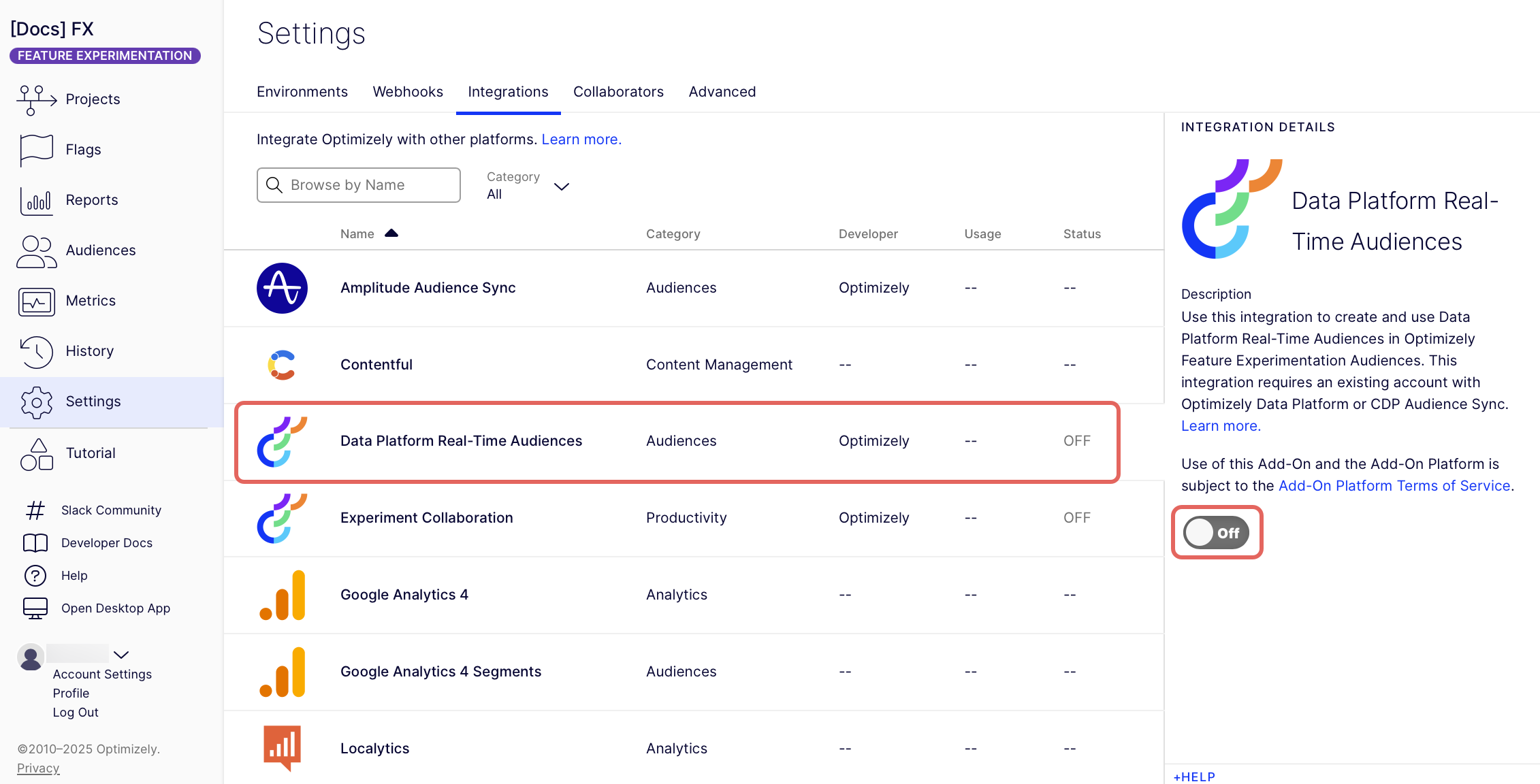
-
Click Accept on the Turn on Integration confirmation window.
Configure Real-Time Audiences in Feature Experimentation
After enabling the integration, complete the following:
-
Click You can find your API key in Optimizely Data Platform (ODP) to go to the APIs page in ODP.
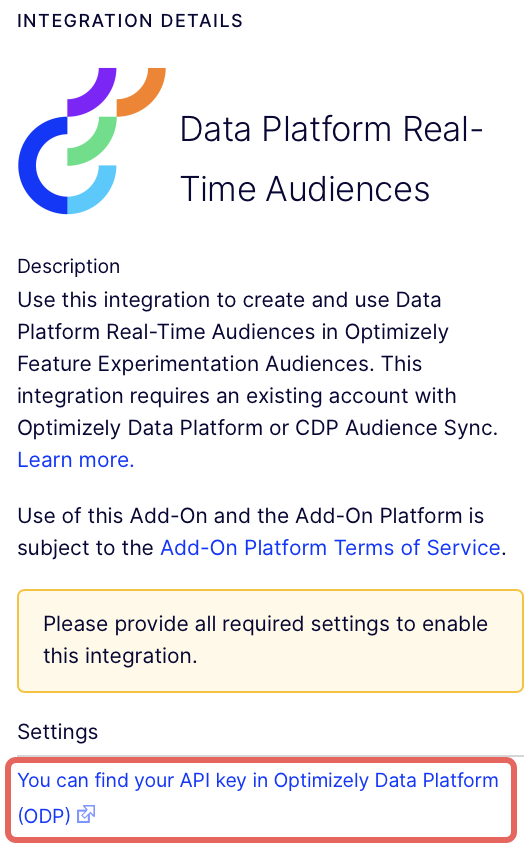
-
Copy the value in the KEY field for both the Public and Private tabs on the APIs page in ODP.

Public
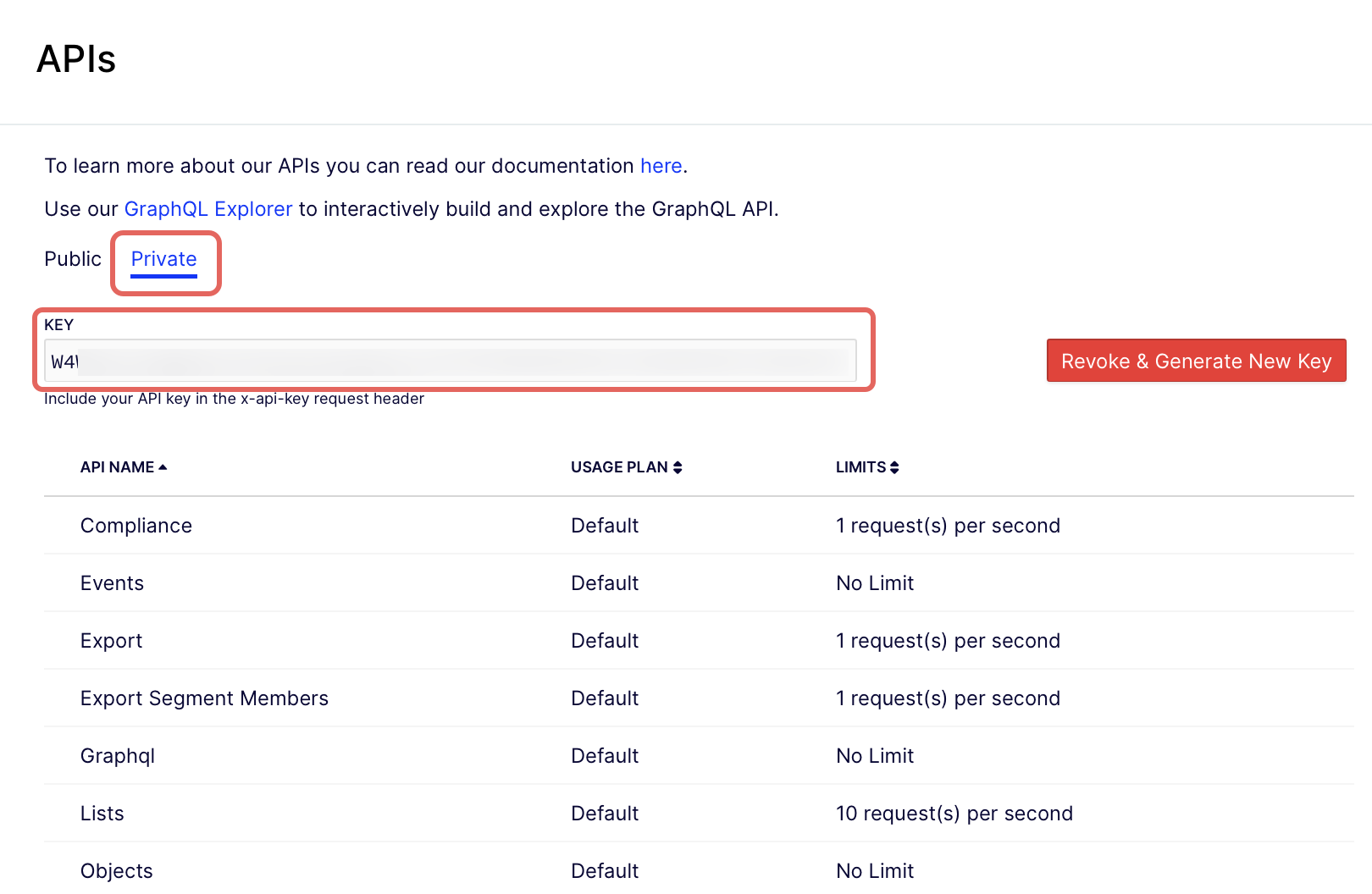
Private
-
Go back to your Optimizely Feature Experimentation project settings and paste these values into the corresponding fields: ODP Public Key (required) and ODP Private Key (required).
-
Select your region from the ODP Host (required) drop-down list.
-
Click Save.
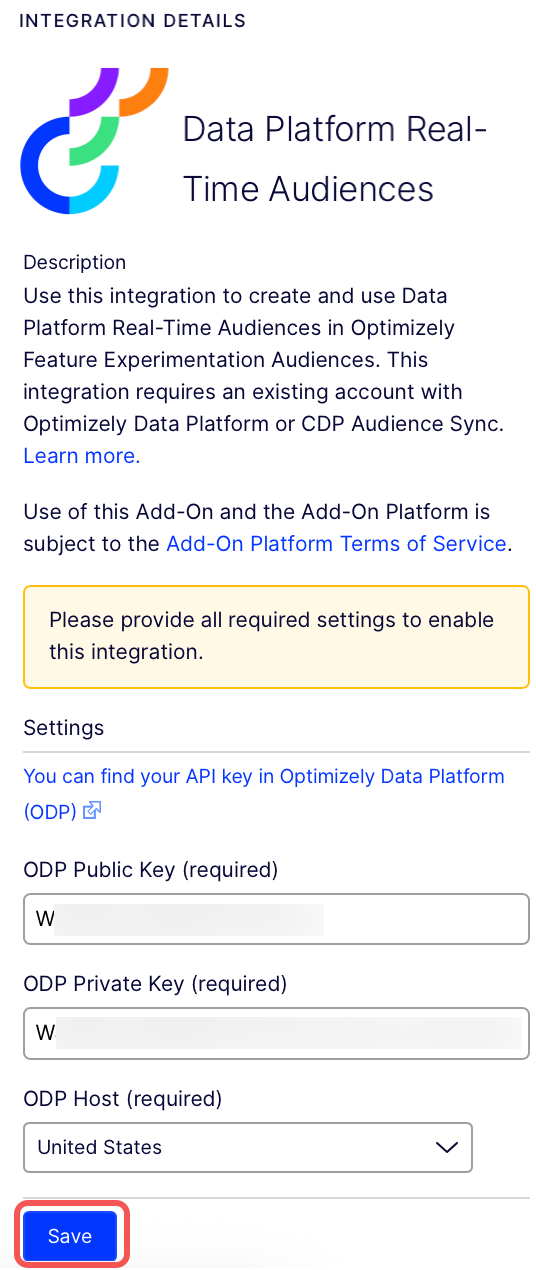
Create a Feature Experimentation audience with Data Platform's Real-Time Audiences
To create a Feature Experimentation audience using ODP's real-time audiences, complete the following steps:
-
Go to Audiences > Create New Audience.
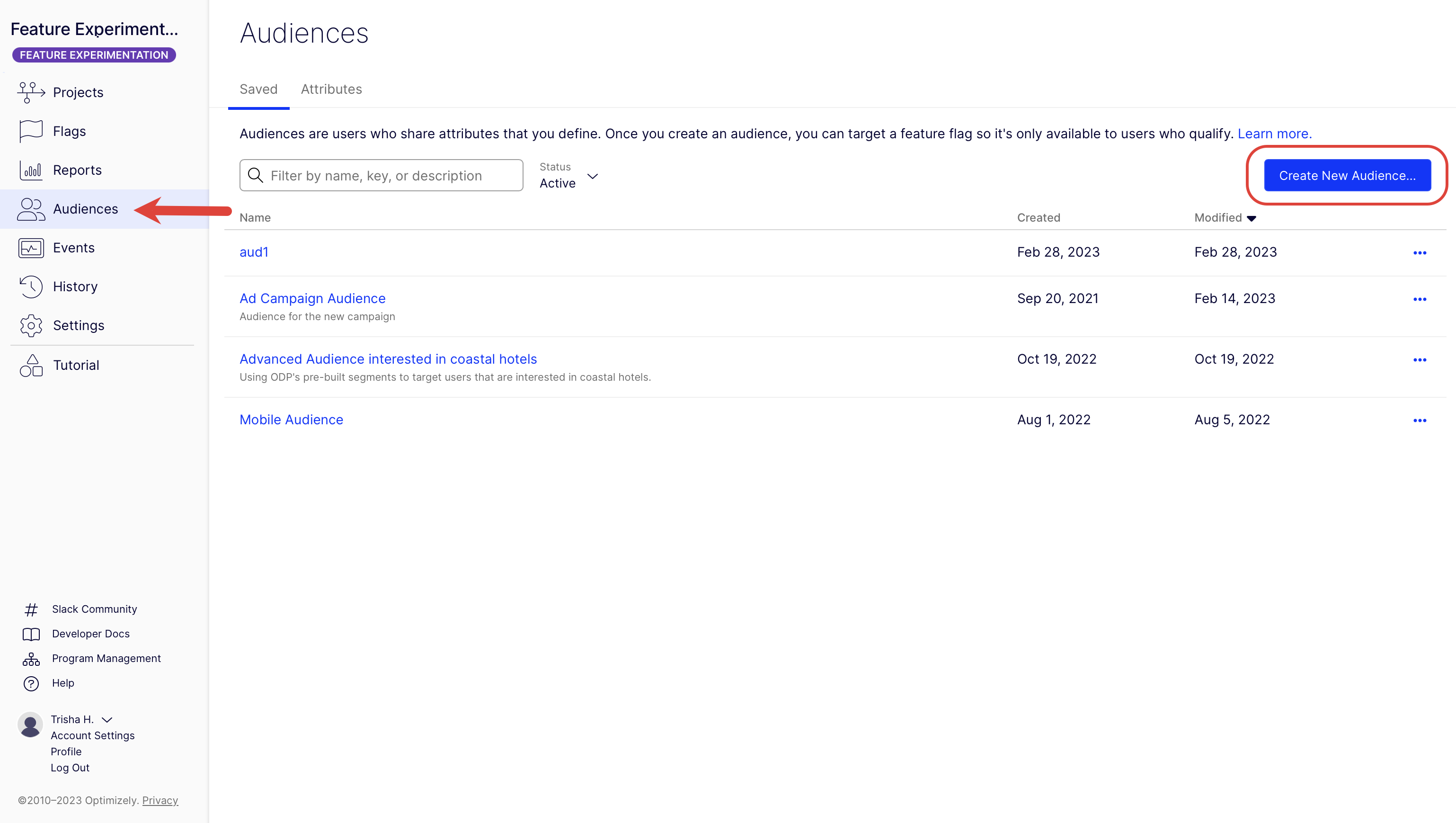 Note
NoteYou can also create an audience in your flag's rule.
After creating your audience, you can reuse it in other flags.
-
Enter a Name.
-
(Optional) Enter a Description.
-
In the audience condition section, expand Data Platform Real-Time Audiences.
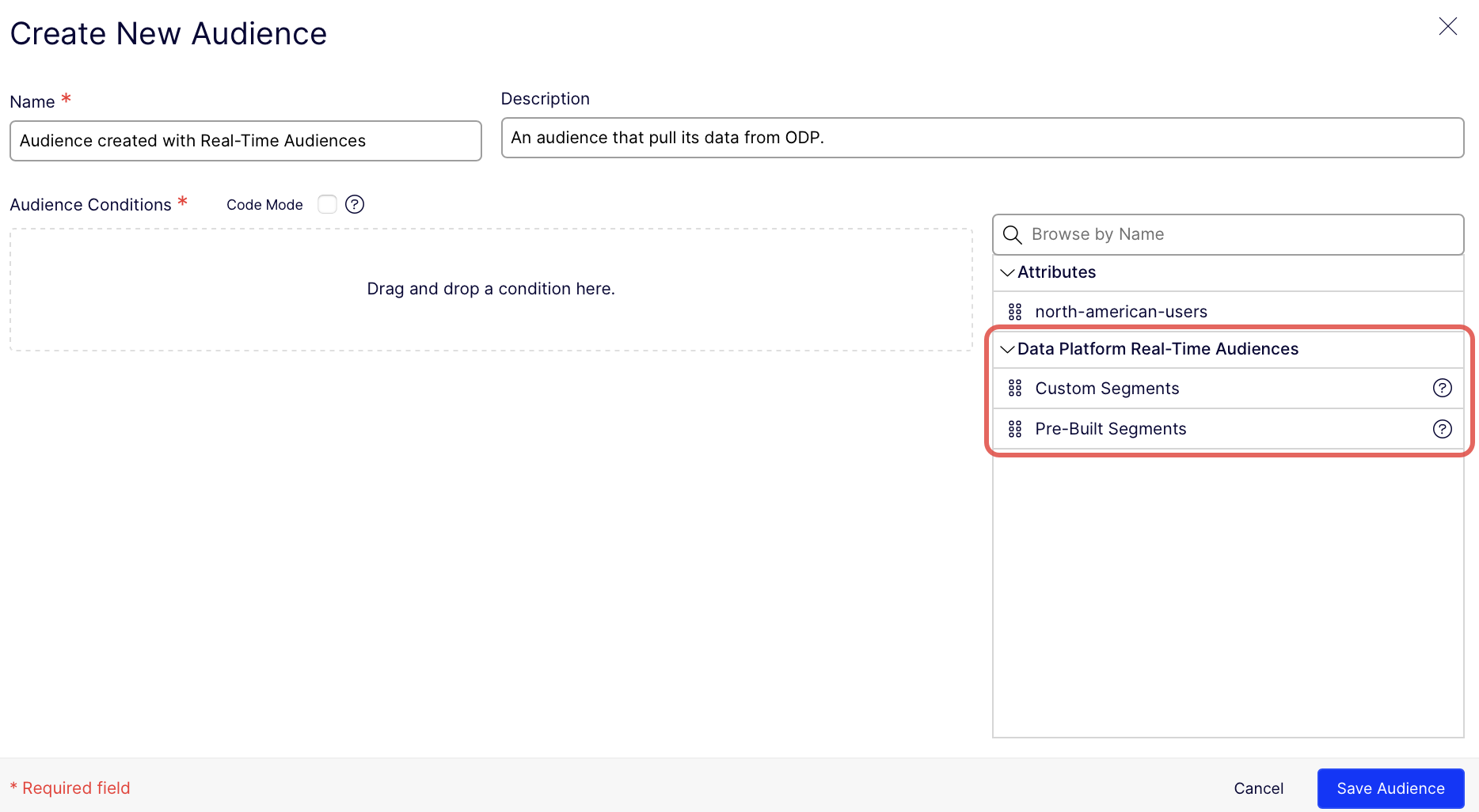 Important
ImportantIf you do not see Data Platform Real-Time Audiences as an option, verify that you successfully configured and enabled the integration.
-
Drag and drop Custom Segments or Pre-built Segments to the Audience Conditions section.
-
Configure the audience as desired (the real-time audiences from ODP display in the Select an audience drop-down list).
-
Click Save Audience.

This creates an audience you can use to target specific users in your targeted deliveries, A/B tests, and multi-armed bandit optimizations.
Integrate Real-Time Audiences in your code
After Implementing the Real-Time Audiences for Feature Experimentation integration and Creating a Feature Experimentation audience with Data Platform's Real-Time Audiences, add your audience to a flag. Then, depending on which SDKs you use, see the following:
- Real-Time Audiences for Feature Experimentation with client-side SDKs.
- Real-Time Audiences for Feature Experimentation with server-side SDKs.
Datafile updates
After creating an audience using Data Platform Real-Time Audiences and attaching that audience to a flag, Feature Experimentation adds a section in your datafile named integrations. This lets your application query ODP for audience conditions and send event data to the ODP server.
- Adding an audience that uses Real-Time Audiences to a running rule and flag adds that audience to the datafile.
- Adding an audience that uses Real-Time Audiences to a paused rule or flag, the audience is not added to the datafile.
ODP limitations and accuracy
Any CDP has some latency from when it receives data until it can stitch together or create a new profile for the customer. During this latency period, you may receive stale information about your customers if you query your CDP.
ODP has the shortest time to accurate results among competing CDPs. ODP usually takes less than 30 seconds, and for 99.999% of the cases, the process takes less than 90 seconds. Many other CDPs take hours or even days to merge data.
It is important to acknowledge this gap in accuracy and account for potentially inaccurate data. If you need your user segments to be 100% accurate 100% of the time, you should manually create your audiences in Optimizely Feature Experimentation and target users through custom user attributes. See Target audiences.
An example of when Real-Time Audiences would not be the right use case is when you want to show a purchase confirmation page right after a customer has bought an item. Because it takes at least 30 seconds for the customer to be added to a has_made_purchase audience segment, you cannot use that segment to decide whether to show the confirmation page. Instead, you should use a custom user attribute that can be updated through your local code and queried immediately.
The following table shows different times during the ODP customer profile lifecycle and whether the information coming from ODP is accurate:
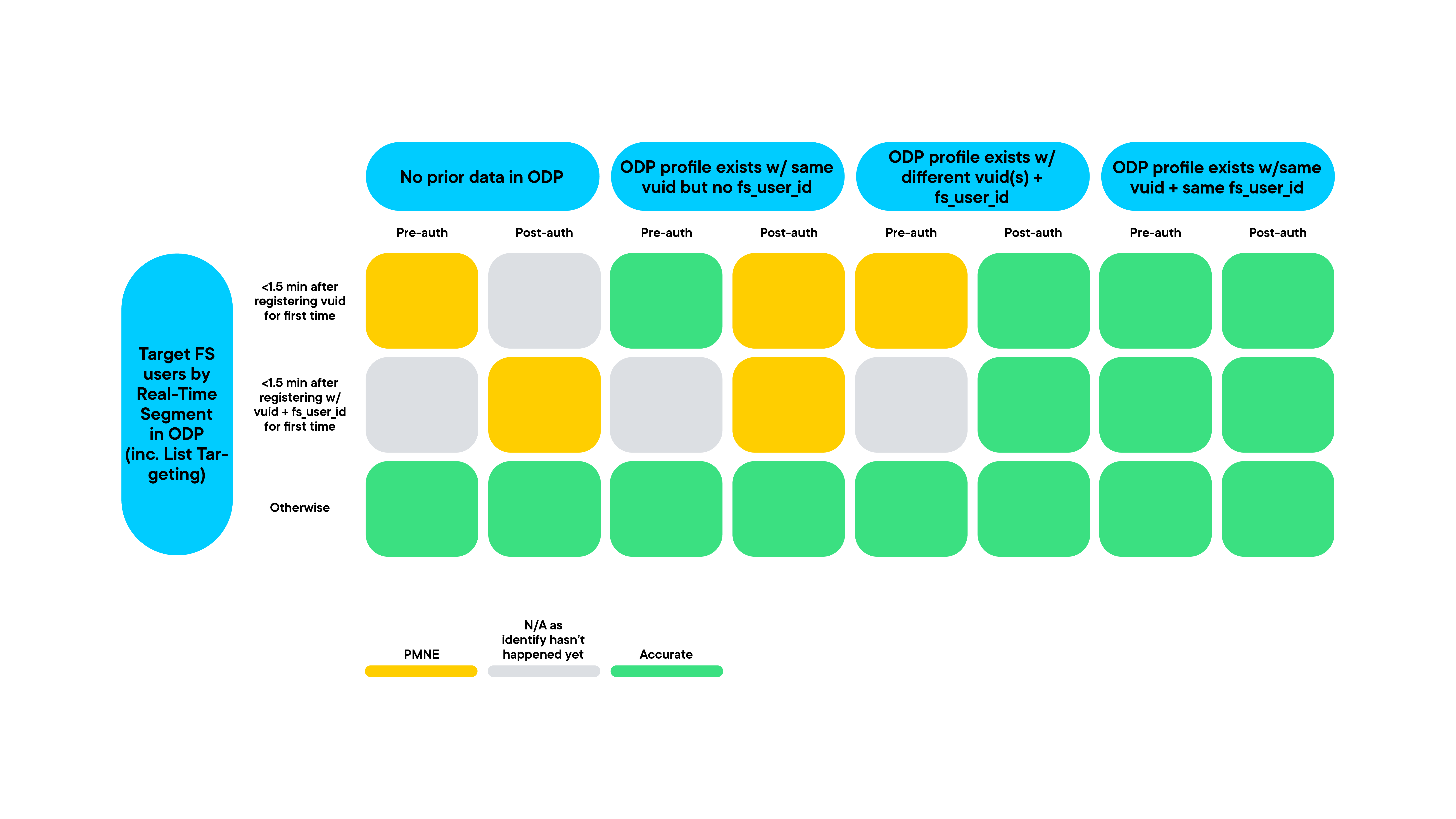
PMNE = Profile may not exist
N/A = Profile not available as identify call has not happened yet
(Click image to enlarge)
VUIDs and client-side IDs
ODP uses various identifiers unique to a specific customer to track that customer's data. One of these identifiers is called a VUID and is an identifier tied to a specific device.
When you initialize a Feature Experimentation client-side SDK, if a VUID does not exist or the SDK cannot find it, you can enable the SDK to create one. This VUID is stored in persistent storage, re-used, and shared across SDK instances within the device. Additionally, you can enable the SDK to send the default app and user tracking data to ODP on VUID creation.
You can use this VUID with the userID you already provide to Feature Experimentation to merge customer profiles. For information, refer to Overview of customer identity and resolution in ODP for information on how to use VUIDs to target audiences or make decisions.
VUIDs and anonymous targeting
Anonymous audience targeting refers to targeting users who have not provided PII, such as their name or email address, but whose behavior or interactions on a website or app can be tracked and analyzed. With anonymous targeting, you can still deliver personalized content or experiences to these users based on their behavior and preferences without knowing their identity.
In Feature Experimentation, you can conduct anonymous targeting through a VUID, which lets ODP recognize and track the user's data across different sessions or devices without revealing their identity. You can use ODP's customer analytics tools to analyze the data and identify patterns and trends that can inform your targeting strategy. Using Feature Experimentation, you can run tailored experiments on these users without storing or collecting PII.
Using anonymous targeting using a VUID in ODP and Feature Experimentation, you can create a personalized, data-driven approach to targeting your audience while protecting their privacy. This approach can help you improve engagement, conversions, and overall user satisfaction.
Updated 1 day ago